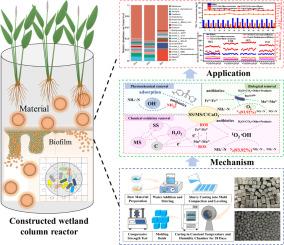Mechanistic Insights and Application of SS/MS/C/CaO₂ Composite for the Simultaneous Removal of Ammonia Nitrogen and Multiple Antibiotics
IF 12.4
1区 环境科学与生态学
Q1 ENGINEERING, ENVIRONMENTAL
引用次数: 0
Abstract
Ammonia nitrogen (NH₄⁺-N) and antibiotics often co-exist in aquaculture effluents, exacerbating ecological toxicity and complicating their removal. A novel multiphase composite (SS/MS/C/CaO₂) was developed, in which steel slag (SS) and manganese slag (MS) served as metal sources, activated carbon functioned both as an electron mediator and adsorbent, and calcium peroxide (CaO₂) functioned as an oxidant precursor, enabling the simultaneous removal of NH₄⁺-N and four typical antibiotics (sulfamethoxazole, enrofloxacin, ofloxacin, and florfenicol). Coupling this material with a microbial system further revealed a “material-microbe” synergy and its potential for pollution control. The optimized composite was formulated with SS:MS = 1:1 and SS+MS:CaO₂ = 3:2, supplemented by 30% cement and 5% activated carbon. Batch experiments demonstrated efficient simultaneous removal of NH₄⁺-N and antibiotics under both acidic and neutral conditions, with removal efficiencies exceeding 70% and 64%, respectively. The system also exhibited strong tolerance to common anions and humic acid, with maximum inhibition of only ∼20%. Mechanistic analysis revealed that the slow release of CaO₂ generated H₂O₂, which served as a continuous oxidant precursor. The redox cycle of multivalent Fe/Mn states in SS and MS sustained an efficient Fenton-like reaction, facilitating the generation of •OH and ¹O₂ via synergistic interactions with the surface functional groups of activated carbon. ¹O₂ was identified as the dominant reactive species, selectively facilitating the conversion of NH₄⁺ to N₂ and effectively degrading key antibiotic structures, thereby mitigating ecotoxicity (OD₆₀₀ of E. coli remained between 1.2 and 1.4 during 24 h of treatment). Continuous flow column experiments further demonstrated that the system consistently achieved 80-99% NH₄⁺-N removal efficiency and 70-99% antibiotic removal efficiency in both simulated and actual aquaculture tailwater. It also enriched dominant bacterial genera (such as Silanimonas, Fontibacter, and Hydrogenophaga) capable of denitrification and antibiotic degradation. Notably, Fe/Mn levels stayed below detection limits, with operating costs 20-35% lower than conventional Fenton-like systems. In conclusion, the composite shows excellent catalytic activity, ecological adaptability, and engineering potential for treating complex pollutants.

SS/MS/C/CaO 2复合材料同时去除氨氮和多种抗生素的机理及应用
氨氮(NH₄+ -N)和抗生素常在水产养殖出水中共存,加剧了生态毒性,使其去除复杂化。以钢渣(SS)和锰渣(MS)为金属源,活性炭作为电子介质和吸附剂,过氧化钙(CaO 2)作为氧化前体,制备了一种新型多相复合材料(SS/MS/C/CaO 2),可以同时去除NH + -N和四种典型抗生素(磺胺甲异唑、恩诺沙星、氧氟沙星和氟苯尼考)。将这种材料与微生物系统耦合进一步揭示了“材料-微生物”的协同作用及其污染控制的潜力。优化后的复合材料配比为:SS:MS = 1:1,SS+MS:CaO₂ = 3:2,水泥用量为30%,活性炭用量为5%。批量实验表明,在酸性和中性条件下,NH₄+ -N和抗生素都能有效地同时去除,去除效率分别超过70%和64%。该体系对普通阴离子和腐植酸也表现出较强的耐受性,最大抑制率仅为~ 20%。机理分析表明,CaO 2的缓慢释放生成了H₂O₂,作为连续的氧化前体。SS和MS中多价Fe/Mn态的氧化还原循环持续了高效的fenton样反应,通过与活性炭表面官能团的协同作用促进了•OH和¹O₂的生成。¹O₂被确定为优势活性物质,可以选择性地促进NH₄+转化为N₂,并有效降解关键抗生素结构,从而减轻生态毒性(处理24 h时大肠杆菌的OD₆₀保持在1.2 ~ 1.4之间)。连续流柱实验进一步证明,该系统在模拟和实际养殖尾水中均能保持80-99%的NH₄+ -N去除效率和70-99%的抗生素去除效率。它还丰富了具有反硝化和抗生素降解能力的优势细菌属(如Silanimonas, Fontibacter和Hydrogenophaga)。值得注意的是,该系统的Fe/Mn含量低于检测限,运行成本比传统的Fenton-like系统低20-35%。综上所述,该复合材料在处理复杂污染物方面具有良好的催化活性、生态适应性和工程潜力。
本文章由计算机程序翻译,如有差异,请以英文原文为准。
求助全文
约1分钟内获得全文
求助全文
来源期刊

Water Research
环境科学-工程:环境
CiteScore
20.80
自引率
9.40%
发文量
1307
审稿时长
38 days
期刊介绍:
Water Research, along with its open access companion journal Water Research X, serves as a platform for publishing original research papers covering various aspects of the science and technology related to the anthropogenic water cycle, water quality, and its management worldwide. The audience targeted by the journal comprises biologists, chemical engineers, chemists, civil engineers, environmental engineers, limnologists, and microbiologists. The scope of the journal include:
•Treatment processes for water and wastewaters (municipal, agricultural, industrial, and on-site treatment), including resource recovery and residuals management;
•Urban hydrology including sewer systems, stormwater management, and green infrastructure;
•Drinking water treatment and distribution;
•Potable and non-potable water reuse;
•Sanitation, public health, and risk assessment;
•Anaerobic digestion, solid and hazardous waste management, including source characterization and the effects and control of leachates and gaseous emissions;
•Contaminants (chemical, microbial, anthropogenic particles such as nanoparticles or microplastics) and related water quality sensing, monitoring, fate, and assessment;
•Anthropogenic impacts on inland, tidal, coastal and urban waters, focusing on surface and ground waters, and point and non-point sources of pollution;
•Environmental restoration, linked to surface water, groundwater and groundwater remediation;
•Analysis of the interfaces between sediments and water, and between water and atmosphere, focusing specifically on anthropogenic impacts;
•Mathematical modelling, systems analysis, machine learning, and beneficial use of big data related to the anthropogenic water cycle;
•Socio-economic, policy, and regulations studies.
 求助内容:
求助内容: 应助结果提醒方式:
应助结果提醒方式:


